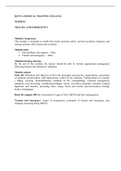Class notes
nursing
- Course
- Institution
Nutrition: is the sum total of the processes involved in the taking in and the utilization of food substances by which growth, repair and maintenance of the body are accomplished. It involves ingestion, digestion, absorption and assimilation. Nutrient- are compounds in foods that are needed by ...
[Show more]



